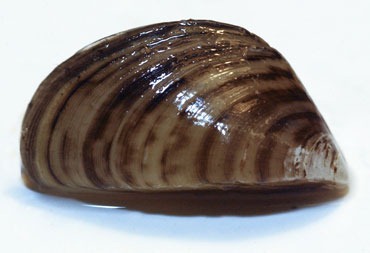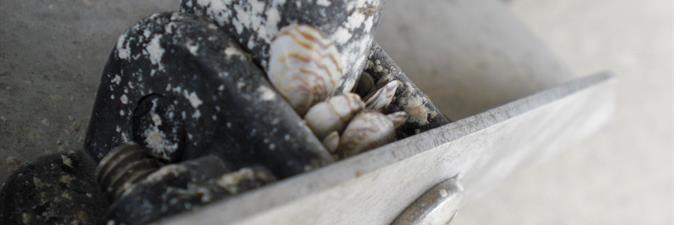What are zebra and quagga mussels?
 Zebra mussels are native to the Black, Caspian and Azov Seas of Eastern Europe. They were discovered in the Great Lakes in Lake St. Clair in 1988 and have since spread to 33 states in the United States.
Zebra mussels are native to the Black, Caspian and Azov Seas of Eastern Europe. They were discovered in the Great Lakes in Lake St. Clair in 1988 and have since spread to 33 states in the United States.
Quagga mussels are native to the Dnieper River Drainage in the Ukraine. They were discovered first in the Great Lakes in the Erie Canal and Lake Ontario in 1989 and have since spread to 27 states in the United States.
How did they get here?
Many aquatic nuisance species, including zebra and quagga mussels, have been introduced into the Great Lakes in the discharged ballast water of ocean-going ships. Another method of dispersal from Europe to the United States is believed to be through transportation of attached mature adults on anchors stored internally in compartments on transoceanic vessels. Once in North American waters, aquatic nuisance species often hitch rides to other bodies of water on the boats, trailers, and equipment that people transport from place to place. Boaters and anglers can inadvertently transport ANS on waders and in bait buckets and live wells.
Zebra and quagga mussels likely made their way to the Western USA on trailered watercraft. The first discovery west of the 100th Meridian was in Lake Mead in 2007. The invasive quagga mussels found in Lake Mead in 2007 were 1,000 miles farther west than any other known colony of quagga mussels at the time. The primary method of overland dispersal of these mussels is through human-related activities, especially trailered watercraft. Given their ability to attach to hard surfaces and survive out of water for extended periods [30 days!], many infestations have occurred by adult mussels hitching rides on watercraft. The microscopic larvae also can be transported in bilges, ballast water, live wells, or any other equipment that holds water.
What do they look like?
Quagga mussels (Dreissena bugensis) and zebra mussels (Dreissena polymorpha) are small freshwater bivalve mollusk-animals with two shells. They are relatives of clams and oysters. It is very difficult for a
 non-expert to tell the two species apart. The shell color of both mussels alternates between a yellowish and darker brown, often forming stripes. Color patterns are highly variable and can be attributed to environmental factors. They range in size from microscopic up to about two inches long. Unlike native North American freshwater mussels, which burrow in soft sediment, adult zebra and quagga mussels can attach to most hard and semi-soft surfaces via tiny threads called byssal threads. Native species do NOT have byssal threads! These byssal threads are one of three main invasive characteristics that give zebra and quagga mussels an advantage over natives, along with rapid reproduction and their ability to filter feed at amazing rates.
non-expert to tell the two species apart. The shell color of both mussels alternates between a yellowish and darker brown, often forming stripes. Color patterns are highly variable and can be attributed to environmental factors. They range in size from microscopic up to about two inches long. Unlike native North American freshwater mussels, which burrow in soft sediment, adult zebra and quagga mussels can attach to most hard and semi-soft surfaces via tiny threads called byssal threads. Native species do NOT have byssal threads! These byssal threads are one of three main invasive characteristics that give zebra and quagga mussels an advantage over natives, along with rapid reproduction and their ability to filter feed at amazing rates.
Where are they found?
Both zebra and quagga mussels can survive cold waters, but cannot tolerate freezing. They can endure temperatures between 1⁰ - 30⁰C (33⁰ - 86⁰F). Zebra mussels need waters above 12⁰C (54⁰F) to reproduce, while quagga mussels can reproduce in waters as cold as 9⁰C (48⁰F). Adult mussels are light sensitive and prefer to live in water around 200 to 300+ feet deep. They are able to live in a wide range of conditions including oxygen-depleted water.

In Colorado:
Highline Lake is the only water in Colorado known to be infested with zebra mussels. There are no known populations of quagga mussels in Colorado.
Pueblo Reservoir State Park tested positive for zebra or quagga mussel larvae (veligers) in 2007, 2008, 2009 and 2011. Pueblo Reservoir was de-listed per regional standards in 2017 and is now considered negative.
Granby Reservoir, Grand Lake, Shadow Mountain Reservoir, Willow Creek Reservoir, Tarryall Reservoir and Jumbo Reservoir all tested positive for one zebra or quagga mussel veliger in 2008. There have been no verified detections at any of these waters since. They were all de-listed per regional standards in 2014 and are now considered negative.
Blue Mesa Reservoir tested positive for quagga mussel eDNA in 2009, 2011 and 2012 by the U.S. Bureau of Reclamation. Blue Mesa was de-listed per regional standards in 2014 and is now considered negative.
Green Mountain Reservoir tested positive for quagga mussels veligers in 2017. Green Mountain was de-listed per regional standards in 2021 and is now considered negative
Highline Lake tested positive for adult zebra mussels in September 2022. Highline Lake is currently classified as "Infested" with zebra mussels.
What are the Impacts?
Zebra and quagga mussels pose a great ecological and financial threat to the state. The invasion of these mussels can affect every Coloradoan and visitors in some way and the impacts could be devastating. Potential impacts include:
- Prolific reproduction
- Clog water infrastructure
- Ecological impacts
- Recreational impacts
- Economic impacts
- Social impacts
- Difficult or impossible to eradicate
- Quick spread to new waters
Help prevent the spread of zebra and quagga mussels!
You can help stop the spread of Aquatic Nuisance Species (ANS) in Colorado and the West!
Before entering and when leaving any waters always:
Clean 
Remove all plants, animals, and mud. Thoroughly wash everything: boats, trailers, vehicle hitches, and motors. Aquatic plant fragments and animals can hide in mud and survive many days out of water. Be sure to clean all fishing equipment including waders and boots.
Drain
Completely drain every space or item that could hold water, including live wells, bait containers, ballast and bilge tanks, and engine cooling systems. Leave the bilge plug out during transport and any time the watercraft is not on the water.
Dry
Allow sufficient time for boats and equipment to dry completely before launching in other waters.
Dispose
Properly dispose unused live bait into trash containers, not into the water. Properly dispose of aquarium or classroom animals or plants, do not place them in any body of water or natural setting.
Report
If you find anything that you think is an invasive species on your boat or in a water body, there are 3 ways you can report it.
For more information on invasive species, please visit:

